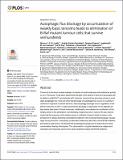Autophagic flux blockage by accumulation of weakly basic tenovins leads to elimination of B-Raf mutant tumour cells that survive vemurafenib
Abstract
Tenovin-6 is the most studied member of a family of small molecules with antitumour activity in vivo. Previously, it has been determined that part of the effects of tenovin-6 associate with its ability to inhibit SirT1 and activate p53. However, tenovin-6 has also been shown to modulate autophagic flux. Here we show that blockage of autophagic flux occurs in a variety of cell lines in response to certain tenovins, that autophagy blockage occurs regardless of the effect of tenovins on SirT1 or p53, and that this blockage is dependent on the aliphatic tertiary amine side chain of these molecules. Additionally, we evaluate the contribution of this tertiary amine to the elimination of proliferating melanoma cells in culture. We also demonstrate that the presence of the tertiary amine is sufficient to lead to death of tumour cells arrested in G1 phase following vemurafenib treatment. We conclude that blockage of autophagic flux by tenovins is necessary to eliminate melanoma cells that survive B-Raf inhibition and achieve total tumour cell kill and that autophagy blockage can be achieved at a lower concentration than by chloroquine. This observation is of great relevance as relapse and resistance are frequently observed in cancer patients treated with B-Raf inhibitors.
Citation
Ladds , M J G W , Pastor-Fernández , A , Popova , G , van Leeuwen , I M M , Eng , K E , Drummond , C J , Johansson , L , Svensson , R , Westwood , N J , McCarthy , A R , Tholander , F , Popa , M , Lane , D P , McCormack , E , McInerney , G M , Bhatia , R & Laín , S 2018 , ' Autophagic flux blockage by accumulation of weakly basic tenovins leads to elimination of B-Raf mutant tumour cells that survive vemurafenib ' , PLoS One , vol. 13 , no. 4 , e0195956 . https://doi.org/10.1371/journal.pone.0195956
Publication
PLoS One
Status
Peer reviewed
ISSN
1932-6203Type
Journal article
Description
This work was supported by five grants to Sonia Laín: Vetenskapsrådet (VR) 521-2014-3341, Cancerfonden (Swedish Cancer Society) 150393, CAN 2014/702, Association for International Cancer Research (AICR) 130086, Barncancerfonden (Swedish Childhood Cancer Foundation) TJ-2014-0038, Barncancerfonden (Swedish Childhood Cancer Foundation) PR-2014-0038; two grants to Ravi Bhatia: Leukemia and Lymphoma Society (LLS) 6137-14 and NIH R01 CA95684; one grant to David P Lane: Vetenskapsrådet (VR) 538-2013-8807; one grant to Marcus J G W Ladds: Karolinska Institute KID Doctoral Student Funding; one grant to Gergana Popova: Karolinska Institutet KID Doctoral Student Funding; two grants to Nicholas J Westwood: Cancer Research UK C21383 and Cancer Research UK A6950; two grants to Gerald McInerney: Vetenskapsrådet (VR) 621-2014-4718 and Cancerfonden (Swedish Cancer Society) 150393, CAN 2015/751; and four grants to Emmet McCormack: Kreftforeningen 182735, Kreftforeningen 732200, Halse Vest 911884, Halse Vest 911789.Collections
Items in the St Andrews Research Repository are protected by copyright, with all rights reserved, unless otherwise indicated.

